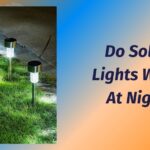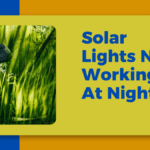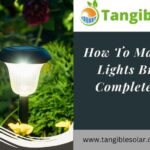How Do Solar Lights Turn On at Night?
Solar lights turn on at night through the use of a sensor that detects low light levels and triggers the light to activate. As the sun sets and darkness falls, the sensor recognizes the change in light and automatically turns on the solar light, allowing it to illuminate the surrounding area.
Solar lights have gained popularity as an eco-friendly and cost-effective lighting solution for outdoor spaces. These lights harness the power of the sun during the day to charge their batteries and provide illumination at night. With their seamless integration of renewable energy, solar lights have become a popular choice for gardens, pathways, and other outdoor environments.
Understanding how solar lights turn on at night is crucial to their functioning. We will explore the mechanisms behind these lights and shed light on the different factors that affect their performance. So let’s delve into the fascinating world of solar lights and discover how they brighten up our nights using the power of the sun.
The Basics Of Solar Lights
Components Of A Solar Light
When it comes to sustainable lighting solutions, solar lights stand out as an eco-friendly and cost-effective option. But how exactly do these lights turn on at night? To understand the mechanism behind solar lights, we need to delve into the basics. Solar lights comprise various components, each playing a vital role in harnessing and utilizing the power of the sun. Let’s explore the key components that make solar lights function seamlessly.
Solar Panel: How It Works And Its Role In The Mechanism
The solar panel is the heart of a solar light. It is comprised of photovoltaic cells that convert sunlight into electricity. These cells are made of semiconductors, such as silicon, which enable the absorption of sunlight and the generation of DC (direct current) electricity. The solar panel consists of multiple interconnected solar cells, carefully arranged to maximize energy conversion efficiency. When sunlight falls on the solar panel, it excites the electrons in the semiconductor material. This excitation generates an electric current, which is then collected and sent to the battery for storage. The solar panel’s efficiency depends on factors like sun intensity, angle of incidence, and the quality and cleanliness of the panel surface.
How to Clean Solar Light Panels
Battery: Its Function In Storing Energy For Later Use
During daylight hours, the solar panel converts sunlight into electricity, but what happens to this energy at night? This is where the battery comes into play. The battery serves as a reservoir, storing the extra energy the solar panel produces during the day. The battery used in solar lights is typically rechargeable and designed to withstand long discharge and recharge cycles. It stores the solar energy as chemical energy in the form of electricity, which is then utilized to power the light fixture when darkness sets in. The battery acts as a reliable energy source, ensuring your solar light continues to illuminate even during cloudy days or extended periods of low sunlight.
Harnessing The Power Of The Sun
The power of the sun is harnessed in various ingenious ways, one of them being solar lights. These innovative devices utilize solar panels to convert sunlight into usable energy, providing a sustainable and environmentally friendly lighting solution. Understanding how solar lights turn on at night requires delving into the science behind solar panel placement, the importance of direct sunlight for optimal charging, the efficiency of solar panels in converting sunlight into energy, and the impact of weather conditions on their performance.
Solar Panel Placement For Maximum Exposure To Sunlight
To ensure solar lights receive maximum exposure to sunlight, the placement of solar panels is crucial. Typically, solar lights are designed with an accompanying solar panel that is affixed to or near the light fixture. The panel should be positioned in such a way that it receives direct sunlight for a significant duration during the day.
Importance Of Direct Sunlight For Optimal Charging
Direct sunlight plays a pivotal role in charging the batteries of solar lights. The solar panel captures sunlight and converts it into electrical energy, which is then stored in the batteries. For optimal charging, the solar panel needs to receive direct sunlight. This means that even on cloudy or overcast days, the solar panel should ideally be positioned in an area where it can receive unobstructed sunlight.
Impact Of Weather Conditions On Solar Light Performance
While solar lights are designed to function even in less-than-ideal weather conditions, it is important to consider the impact of weather on their performance. Cloudy, rainy, or snowy conditions can reduce the amount of sunlight reaching the solar panel, thus affecting the charging process. However, modern solar lights are equipped with advanced technologies that can compensate for reduced sunlight by storing excess energy during sunny periods for use during darker times. It is advisable to ensure proper maintenance and cleaning of solar panels to maintain optimal performance, especially after extreme weather events.
Understanding The Energy Conversion Process
Understanding the energy conversion process is crucial for comprehending how solar lights can turn on at night. It involves the transformation of solar energy into electrical energy, which is then efficiently stored and managed to maintain light output. Let’s delve into how this process works.
Conversion Of Solar Energy Into Electrical Energy
The conversion of solar energy into electrical energy is the core mechanism behind the functioning of solar lights. An essential component of solar light is the photovoltaic (PV) cell or solar panel, which captures sunlight and converts it into direct current (DC) electricity.
The PV cells consist of semiconductor materials, such as silicon, that have the unique property of producing an electric current when exposed to sunlight. When sunlight strikes the solar panel, it excites the electrons in the semiconductor material, causing them to flow and generate an electric current. This process is known as the photovoltaic effect.
The generated DC electricity is then fed into a battery for storage and usage when required.
Battery Capacity: The Role It Plays In Maintaining Light Output
Battery capacity plays a crucial role in maintaining the light output of solar lights. It establishes the maximum amount of electrical energy that the solar lighting system can store and use.
It is important to choose a solar light system with an appropriate battery capacity to match the intended usage requirements. Identifying the optimal battery capacity ensures the solar light can effectively sustain its light output throughout the desired period, offering reliable illumination during the night.
In conclusion, understanding the energy conversion process is vital for comprehending how solar lights turn on at night. The conversion of solar energy into electrical energy, the storage of excess energy in batteries, and the role of battery capacity are all essential elements in ensuring efficient operation and maintaining light output for solar lights.
Illuminating The Night: The Role Of Light Sensors
When the sun sets and darkness starts to envelop the world, solar lights play a crucial role in brightening up outdoor spaces. But have you ever wondered how these solar lights seem to magically turn on at night? The answer lies in the ingenious technology of light sensors.
Light Sensor Function: Identifying Darkness To Activate The Light
At the heart of every solar light’s ability to turn on at night is the innovative technology of light sensors. These sensors act as the eyes of the solar light, detecting the absence of light or darkness in the surrounding environment. When the light sensor detects darkness, it triggers the activation of the light source, allowing the solar light to illuminate the area.
Sensitivity Adjustments To Adapt To Different Lighting Conditions
Solar lights are designed to operate in a variety of lighting conditions, ranging from complete darkness to low light levels, such as during dusk or dawn. To ensure optimal performance, light sensors are equipped with sensitivity adjustments. These adjustments allow the sensors to adapt to different lighting conditions, ensuring that the solar light accurately detects darkness and activates the light source accordingly.
Importance Of Proper Positioning For Accurate Sensor Readings
The positioning of the solar light plays a critical role in the accurate readings of the light sensor. When installing solar lights, it is important to consider factors such as obstructions, surrounding structures, and shadows that may interfere with the sensor’s ability to detect darkness. Proper positioning ensures that the light sensor receives accurate readings, allowing the solar light to function optimally and provide consistent illumination throughout the night.
Enhancements In Sensor Technology For Increased Accuracy
As technology progresses, so does the advancement of light sensor technology. Manufacturers are constantly striving to improve the accuracy and reliability of light sensors in solar lights. Enhanced sensor technology now incorporates features such as multi-spectral sensors, which can detect even the subtlest changes in light levels, leading to more precise activation of the light source. These advancements ensure that solar lights provide consistent and reliable illumination, even in challenging lighting conditions.
Lighting The Way: Led Lights And Their Efficiency
LED lights have revolutionized the world of solar lighting technology, offering energy-efficient and long-lasting illumination that lights up our paths even after the sun sets. With their incredible efficiency and versatility, LED lights have become an essential component of solar lighting systems. In this section, we will explore their role in solar lighting technology, their energy consumption compared to traditional light bulbs, and the different color temperature options they provide for various applications.
Led Lights: Their Role In Solar Lighting Technology
In solar lighting systems, LED lights play a crucial role in converting solar energy into visible light. LED stands for Light Emitting Diode, a semiconductor device that emits light when an electric current passes through it. Unlike traditional incandescent bulbs, LED lights do not depend on heat to produce light, resulting in significantly less energy waste.
Comparing LED Lights To Traditional Light Bulbs In Terms Of Energy Consumption
When it comes to energy consumption, LED lights have a significant advantage over traditional incandescent bulbs. While old-fashioned light bulbs waste a considerable amount of energy as heat, LED lights convert a higher percentage of electrical energy into visible light, resulting in reduced energy consumption and increased efficiency. This energy efficiency not only benefits solar lighting systems, which rely on l but also contributes to cost savings and a more sustainable approach to lighting our surroundings.
Frequently Asked Questions Of How Do Solar Lights Turn On At Night
How Does a Solar Light Know When to Come On?
Solar lights have built-in sensors that detect the amount of sunlight. When it gets dark, the sensor tells the light to turn on.
Do solar lights turn on automatically?
Yes, solar lights have automatic sensors that detect the absence of sunlight and turn on the lights at dusk.
Why are my solar lights not working at night?
Solar lights may not work at night due to various reasons, like insufficient sunlight exposure, low battery power, dirty solar panels, or faulty wiring.
How Do You Tell If Solar Lights Are On or Off?
To check if solar lights are on or off, simply cover the solar panel and see if the lights turn on. If they do, the lights are working. If not, they are off.
Conclusion
To sum up, solar lights are designed with built-in sensors that activate the light when darkness falls. These sensors are typically programmed to detect low levels of natural light, triggering the solar panel to convert sunlight into energy stored in built-in batteries.
As night falls, the stored energy is used to power the LED lights, illuminating pathways, gardens, and outdoor spaces without the need for external electricity. Solar lights provide an eco-friendly and cost-effective solution for outdoor lighting needs, reducing reliance on traditional power sources.




